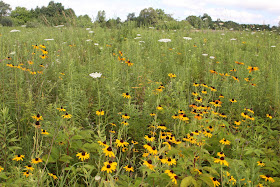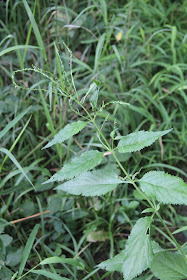One of my favorite wildflowers of the season is Spotted Joe-pye Weed. This plant has recently been reclassified and renamed. Formerly lumped with the Boneset species and known as Eupatorium maculatum, it has been broken off and renamed Eupatoriadelphus maculatus. In some sources it is also listed as Eutrochium maculatum. Just when I could remember Eupatorium maculatum! All of my books -every single one of them- refers to to the plant as Eupatorium maculatum. Of course scientists have also done away with the genus Aster, and many of the Goldenrods are no longer Solidago species...
EDIT: It appears that the name of this species has been settled as Eutrochium maculatum. This is how the USDA Plants database has it listed.
Spotted Joe-pye Weed (regardless of its binomial nomenclature) is a large showy wildflower of wet places. It is mostly found in wetlands and along shorelines. The plant grows to a height of between 2 and 10 feet, but is usually in the 3 - 5 foot range in Mid-Michigan. Overall the plant can be found in 23 American states and 7 Canadian provinces. Primarily a Northeastern species, its range dips as far south as Georgia in the Appalachians and as far west as Minnesota and Iowa.
.JPG) |
| Spotted Joe-pye Weed |
The plant blooms in a large flat-topped cluster of pink to purple flowers. Each flower consists of between 8 and 20 disk florets with no ray florets. The long thin disk florets give the flower an overall fuzzy appearance. The flowering head on each plant may be up to seven inches across and be composed of hundreds of individual flowers. Individual plants bloom between July and September and usually bloom for 3 to 4 weeks.
 |
| Spotted Joe-pye Weed - not the dark purple spots on the stems and the feathery looking disk flowers |
The stems of Spotted Joe-pye Weed are purple and sometimes have darker purple spots - a related species Sweet Joe-pye Weed has green stems with purple only at the leaf joints. The leaves of Spotted Joe-pye Weed are yellow-green to deep green with serrated margins and grow in whorls of four to five leaves. Each leaf is up to 7 inches long and 2 1/2 inches wide and is lanceolate or elliptical in shape.
 |
| Spotted Joe-pye Weed - note the deep purple stems and serrated leaves |
The origin of the name Joe-pye Weed is somewhat a mystery. The common legend is that Joe Pye was a Native American healer in Massachussetts who used the plant as part of a treatment to induce sweating and break fevers - including an outbreak of Typhus. There is actually lineage of Native Americans from Massachussets who adopted the surname Pye, so there may be some truth to this legend. For a deeper examination of origin of the Joe-pye Weed name read this blog post at prairieworksinc.com
Basic Information
Spotted Joe-pye Weed
Eutrochium maculatum (formerly Eupatoriadelphus maculatus, formerly Eupatorium maculatum)














































